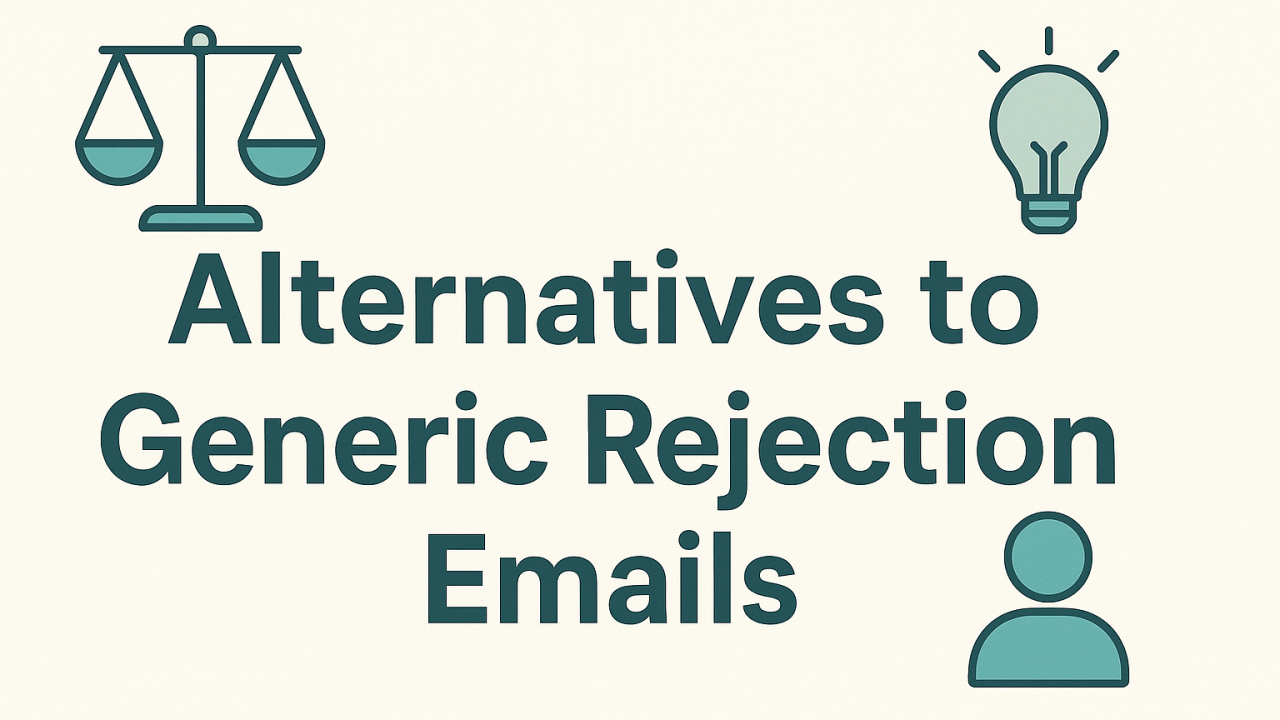Disclaimer 1: The views and opinions expressed in this article are solely my own and do not represent the official stance or policies of my previous / current employer. This is a personal perspective aimed at promoting fair and transparent hiring practices.
Disclaimer 2: Solution ideas mentioned here are draft / raw. They should be treated as a foundation and be improved in cooperation with legal / Councils / HR / C-level professionals.
If you’ve ever applied for a job, you know this line:
“After careful consideration, we regret to inform you…”
Or / And you most probably see email similar to this:

It’s polite on the surface, but in reality it feels cold, generic, and completely useless. For many candidates, it erases all the good experience they had during the interviews.
Why HR still send these emails?
When I wrote about this issue on LinkedIn, many HR professionals pushed back. They said things like:
- “Any detail can be seen as bias and turn into a lawsuit.”
- “Legal department is not approving it.”
- “In Europe, works councils approve only these safe templates.”
- “GDPR, GDPR, GDPR….”
And they’re right.
But I refuse to keep calm, ignore the issue and do nothing about it.
As a Software Engineer I learned that every problem has potential solution. So I believe that are still ways to do better. And I want to brainstorm ideas with you.
Alternatives that will break the ice.
1) Categorized feedback
Instead of 1 standard rejection template, HR picks one or two reasons rejections list, e.g.
- “Another candidate had more relevant experience in X.”
- “Another candidate gave stronger examples in the interview.”
This reasons can be used to send more detailed / personalized templates approved by Legal / Work councils
This isn’t perfect, but it’s better than a 1 generic rejection for all cases. A practical tip from Breezy’s guide: work with legal to agree safe templates and use them consistently (source).
2) Two-level approach
- Early-stage candidates get the standard rejection (or rejection from 1st point above).
- Finalists get a short call or a slightly more detailed note.
This respects the time they invested. Breezy’s FAQ even suggests focusing feedback on those who actually interviewed, and using safe, pre-approved wording for scale (source).
3) Feedback on request
Add a link in the rejection email: “Want feedback?” Before receiving it, the candidate accepts a disclaimer: “This is not a legal explanation, just a learning note.” Only people who really want it will click, and you keep the risk low.
4) AI as a re-writer (not a decision-maker)
Example flow:
- Recruiter / Interviewer notes feedback about interview in scorecards.
- AI rewrites it into a softer, neutral sentence; the recruiter approves before sending.
This is already a documented internal use: merging raw interviewer notes into a clean summary or narrative (source)
5) AI interview transcriber (where allowed)
In countries or companies where the works council/legal framework permits it, AI can act as a neutral transcriber during interviews.
That means:
- Every answer is captured verbatim.
- Recruiters can later highlight specific examples from the transcript (“You mentioned X as your main project, but we were looking for Y”).
- AI can help package these notes into bias-free, factual feedback, sometimes even quoting the candidate’s own words as context.
This reduces subjectivity (“the interviewer felt you lacked depth”) and anchors feedback in evidence (“you described working on a 2-person project, but the role required leading a 10-person team”).
One more note on AI and “fair” feedback
There’s an interesting point from the World Economic Forum:
Perhaps the most counterintuitive benefit of AI in hiring is in relation to rejection. Employers traditionally provide little feedback to unsuccessful candidates, citing time constraints and legal risk. AI changes this dynamic. Because candidates are evaluated against explicit rubrics, the same data that supports hiring decisions can also be repurposed into individual feedback.
✅ Put together, the strong solution can look like this:
- Define role-specific rubrics.
- Force interviewers to fill them in (structured scorecards).
- Auto-generate rejection feedback from rubric data using pre-approved modular templates.
- Recruiter only clicks “send.”
This way:
- Legal risk → minimized (feedback = objective rubric reference, not opinion).
- Workload → minimized (AI + automation does the heavy lifting).
- Standardization → maximized (consistent templates, modular building blocks).
Why this matters
Candidates invest time and energy. Rejection doesn’t have to feel like a brick wall.
Paradox is that in this way you also damage reputation of your company.
Even within legal limits, you can give people a clearer, more respectful ending.
Do not forget. No one is safe from losing the job today. Especially in the layoff era.
When that day comes, I’m guessing you’d also like to know why you got rejected during your job search.
So my question to you is: Which of these could your company actually try next quarter?
